Background of Australian federation
The Australian federal system is a unique hybrid of the British Westminster system and the US congressional style. It draws from the British in that it fuses the executive and legislative branches, with the Prime Minister and their Cabinet sitting within the legislature – this is opposed to the US system that separates the role and duty of the President. From the US system, it takes the design of the Senate. While the lower House of Representatives, like its equivalent Houses of Commons in the UK and Canada, represents the people of the nation, the Senate is home to the interests of the states and territories.
The Senate is constituted by elected Senators who serve longer terms, and represent the entirety of their state. The Constitution provides that all of the ‘Original States’ (that being the six colonies that formed Australia at the time of Federation) must have an equal number of Senators, no less than six apiece but numbering twelve each in the current Parliament. The two mainland Australian territories were later given self-government and representation in the form of two Senators apiece, and it is predicted that any future states would be entitled to Senate representation roughly corresponding to their population. This is a contrast to the US system, wherein each state is flatly entitled to two Senators regardless of the time of their accession to the Union, providing a level of privilege to the original members of the Federation.
This bicameral approach is viewed as critical in the administration of a federal Australia. The Senate was not designed to be an equal representative of the Australian people, but rather as a method for smaller states to protect their interests in the face of majority rule in the House of Representatives – a role not dissimilar to the European Union’s Council. This is of particular relevance to Europe, a point I will address.
Structural dissimilarities
The creation of this Australian Federation is explored by Deakin University’s Dr. Carolyn Holbrook, who described the Federation as steeped in democratic and civil optimism. It was ‘experimental’ and shameless in essentially plagiarising the favourite parts of the two systems, as well as adding unique Australian twists. One example of this is the method of Constitutional amendment, requiring a ‘double majority’ – i.e., more than 50% of the people in more than half (i.e. 4 out of 6) of the States, plus an overall national majority.
The Australian experience was also unique for the credentials of its authors. They were sometimes far from the British aristocracy, from backgrounds including iron-mongers, journalists, schoolteachers, and goldminers. One was even a vegetarian. Uniformly, however, they were white men and subjects of the British Empire. They were speakers of a common language and residents of a set of reasonably common colonies. And, as the 1901 Census showed, a mere 3.7 million people inhabited the continent. To boot, there were only six colonies to federate – there had been plans originally for seven, but New Zealand elected to forge its own path as an independent nation (although they could theoretically federate with Australia at any time if they so choose.)
The European Union is a tremendously more complex and diverse organisation. 28 Member States (including Europe’s own New Zealand-esque situation in Brexit), 24 official languages, and nearly 500 million citizens create a need for a very robust federal system.
European challenges and the Australian experience
This presents a challenge of culture and organisation. The EU’s motto is In varietate Concordia – United in Diversity. This diversity is valuable, and should for a great many reasons be preciously supported. A European federation can, however, base its structure on the experiences of the Australian Constitution, while protecting the independence needed to breathe life into rich and historic cultures.
To explore this, one must note the secondary challenge posed by population imbalances of the EU Member States. In Australia, the widest gap between populations of states is between New South Wales and Tasmania, home to 7,704,300 and 518,500 residents respectively – thus, NSW is close to 15 times larger than Tasmania, though both states are given the same powers of government. Europe replicates and intensifies this dynamic, with the population of Malta able to fit into Germany more than 179 times over.
To overcome this, I would suggest creating a unique four-tier system, consisting of the federal government, 27 ‘Nations of Europe’ (assuming the completion of Brexit), a total of 86 states, and local governments beneath them. The role of the federal European government and local governments would be analogous to other federations around the world, including Australia. The devolution of powers is addressed later in this article.
Australian ideas
The States are relatively easily explained. In order to reduce the population imbalance identified above, a federal Europe should adapt the EU’s Classification of Territorial Units for Statistics geocode standard. The standard is already in use for public procurement and administration of the EU structural funds (not dissimilar to federal funding grants in Australia) and breaks the European Union down into manageable population regions. The State level could be at Level 1 (called NUTS 1, after the French acronym) and would, with some exceptions, create States with populations between 3,000,000 and 7,000,000 people. NUTS 1 are the largest areas and are formed along socio-economic regions whilst maintaining the population balance as much as possible. This will divide the management and delivery of services into new States for some Member States, especially Germany, though a total of 12 Member States would actually remain their own State. There are no multinational NUTS 1s, so each State would retain distinct cultural heritages. It is a system that is readily made and researched, and clearly deliverable. It would further allow for a devolution of power to local hands, providing relevant and useful outcomes for residents.
The ‘Nations of Europe’ concept is a method of retaining the current cultural borders of the European Union. They would occupy a unique level of governance, with a distinct focus on maintaining cultural heritage whilst leaving the relatively utilitarian affairs of governance to the States. This could include running various programs and agencies that support a NoE’s official languages, symbols, heritage places and artefacts, foods and drinks, national sports leagues, ceremonies, and royal families. This may include broadcasting agencies, heritage bodies, museums and galleries, sporting authorities, and film funding and support agencies.
If a European Federation would decide on a bicameral system, the Australian experience would suggest an additional role for these NoEs, acting as the electorates for the European Senate (or equivalent.) The Australian Constitution provides that the number of members of the House of Representatives should be ‘as nearly as practicable’ twice the number of Senators – thus, 151 members and 76 Senators. Play that in reverse for Europe, and with 750 current MEPs, we find room for some 375 European Senators – assuming 27 NoEs and an equal number of Senators for each of them, and the closest practicable number of European Senators becomes 378 with each NoE entitled to elect 14. This of course gives each German Senator a constituency of nearly 5.9 million people, with a cosy 32,878 for each Maltese Senator. Their direct elections would likely be a welcome change from the accusations of democratic deficits currently thrown in the EU.
As a distinct note, this would support a European resurgence of regionalism that is often seen in a separatist or nationalist light. This includes the ever-ongoing Belgian separatist movements, the Catalonian movement, and the Corsican movement. Separating as independent nation-states is generally considered a mutually damaging prospect due to economic and political ramifications. There is, additionally, no system in place to immediately re-enter the European Union as a Member State.
The Australian Constitution, in contrast, provides for permission for new States to be formed in a number of circumstances, including by breaking away from the established territory of an existing state. They would be, however, a full state of Australia and would be immediately entitled to representation in the Senate, though there would be no guarantee of equal numbers. There is no need for federal government consent to make this possible (although secession from the Federation itself is not possible) and it therefore requires only the consent of the Parliament/s of the concerned state/s. In the European context, using Catalonia as an example, this would entail Catalonia separating from Spain, with the approval of the Spanish NoE. Catalonia would then be reformed within the European Federation as a new Nation of Europe, with a NUTS 1 state (or multiple) being established to handle their practical governance. This Catalonian NoE, however, would not be entitled to an equal 14 Senators, and would receive Senators based on their population. In this way, the people of Catalonia would have been able to exercise both self-determination, support their cultural heritage and identity, whilst doing as a part of a European Federation.
For the resident citizen? They may never have noticed. They still travel on a European Federation passport, still put their mail into a EuroPost (or DHL, let’s be honest) mailbox, pay for their escudella with euros, and can freely travel, work, and live in any part of the European federation.
From a less legalistic perspective, I believe the greatest challenge of a federal Europe will emerge in its social origin. The majority of the world’s federal states trace their lineage as a united nation as a response to an outside pressure or chaotic element, or otherwise as a simply natural conclusion because of their status as a relatively culturally homogenous settler colony. The latter one is the very quick story of Australia. Europe is not a continent where federal states have historically emerged. Moreover, a European federation is not going to be born from fire and war. It will almost certainly not be as a catalytic response to an existential threat. It will be a dedication to each other, not as nations, but as fellow Europeans, for democratic ideals and an evergreen commitment to peace. I hope this can become the most outstanding value espoused in a European Constitution.



Follow the comments: |
|
